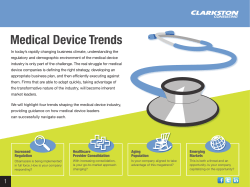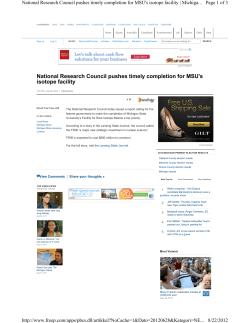
Document 109835
• HEALTH CARE! November - December Charge Master Why do some hospitals in the same city or state charge thousands of dollars more for the same procedure? As one doctor argues, big insurance, big hospitals, and big pharma firms have been making backroomdeals that drive up medical costs. BY ILENE WOLFF! ILLUSTRATION BY TONWEN JONES 40 OBUSINESS I NOVEMBER - DECEMBER 2013 2013 t a recent medical conference in Ann Arbor, the cofounder of an Oklahoma surgery center told the assembled doctors about a daring move he made a few years ago: He started a price war by making the center's surgery prices all-inclusive, then boldly posted them online and charged patients for orthopedic spine hardware at cost instead of marking the price up. "Why can't we do that in Michigan?" asked someone in the audience. That prompted a dispiriting story from another doctor, whose medical group tried to set up its own surgery center in Michigan and, as in Oklahoma, make its prices transparent. But a nearby hospital was having none of it. It hired a ''high-priced law firm" to fight every request the group filed with the state for certificates of need - approvals required to open a surgery center, buy highpriced equipment, or add more hospital beds. The hospital even sent letters with veiled threats of repercussions to doctors if they made referrals to the planned center. The hospital and its lawyers won the battle; the entrepreneurial doctors had to scrap their plans for new operating rooms. But the heavyhanded hospital did not exactly win the war against competition and transparency, as some parts of its' list of charges are now available for public scrutiny. That's because in May the u.s. federal agency Centers for Medicare and Medicaid Services, known as CMS, posted online charges from more than 3,000 hospitals nationwide for the 100 most common inpatient procedures and 30 common outpatient procedures paid for by Medicare. The amounts were culled from each hospital's "charge master" - a comprehensive, legally required list detailing what the institutions charge for everything from aspirin to an artificial hip. Almost no one ever pays the charges listed on a hospital's charge master. Washington basically ignores charge masters and tells hospitals how much it will pay for people insured through Medicare and Medicaid; insurance companies routinely negotiate payments that are less than the listed charges - and many hospitals offer discounts to individual patients who pay directly for services. Although media coverage about the CMSposted data focused on how high the charges were, and on the disparity among charges at hospitals in the same state or even the same city, the pricing situation is even murkier than that. The fact is, charges can vary widely even among hospitals within the same system. For example, the average charge for treating a Medicare patient with a heart attack at Henry Ford Hospital in Detroit is $14,725.67, according to CMS data. However, Medicare heart attack patients treated at Henry Ford Health Systerns Wyandotte Hospital save about $5,000 because Wyandotte's average price is $9,722.51. Henry Ford's management declined to talk about the price discrepancy or its charge master for this article. Experts say there are some legitimate, market-based reasons for varying charges, including patient volume, average length of stay, the cost of ancillary services and overhead, supply chain costs, bad debt, and government payment shortfalls. But if hardly anyone pays the amounts listed on a hospital's charge master, why did the Patient Protection and Affordable Care Act require CMS to publish the data? At the very least, CMS' charge master disclosures, which have been downloaded more than 300,000 times, will help whittle away at the opaque health care marketplace that's been in place for 50 years, says Dr. Matt McCord, an Ann Arbor anesthesiologist. McCord is the secretary of the Michigan chapter of Docs4PaJ:ientCare.org, a national physician advocacy group that was formed because it opposed passage of the Affordable Care Act. Look at the food stamp program, McCord argues. He says food stamps work without pushing up food costs because they're used in an open market where prices are transparent and consumers can shop for the best buy. America's health industry, on the other hand, takes the opposite approach. "The way health care has operated is with big insurance, big hospitals, and big pharmaceutical companies making backroom deals that drive up the cost for everyone;' he says. LOWER COSTS MEAN BETTER QUALITY Dr. Katherine Hempstead, senior program officer at the Robert Wood Johnson Foundation in Princeton, N.J., a national philanthropic organization devot~d to public health, was glad to see CMS publish the charge master list. She says the report has people talking not only about price, but also about quality. "I think a lot of people sort of want to know, when there's this big variation in cost, what's driving this?" she says. "One might wonder, is it the case that hospitals that charge more have higher quality?" Indeed, studies show consumers think higher prices mean better quality, but health care experts aren't so sure. Dr. Jeff Rice, CEO of Healthcare Blue Book, which tracks hospital pricing and quality, says that, in fact, the opposite could be true. "More often than not, the good studies show that lower costs mean better quality;' he says. That's because cost comes down and expertise improves as a provider's volume increases. Dr. John Fox, senior medical director at Priority Health, a nonprofit health plan based in Grand Rapids, says there's not a strong correlation either way. But Hempstead is agnostic on the issue. "Whatever it means;' she says, ''hopefully it will stoke interest among patients to get more information, and hopefully that will push down prices:' That happened with dental implants, Lasik eye procedures, and cosmetic surgeries. Because patients pay for these services out-ofpocket, and because they're not particularly time-sensitive, consumers can shop around for the best value. A doctor whose charges are too high can price himself out of the market. MORE PATIENTS ASK MORE QUESTIONS When it comes to nonelective services, Hempstead's hope that patients will be interested in getting more price and quality informa- she called around to health care executives she knows in search of an explanation - but she had no luck. She says one told her, "To tell you the truth, I don't even understand our charge master." Adds Mitchell: "I threw up my hands at one point:' Others downplay the importance of a charge master. "I don't think hospitals pay a lot of attention to the charge master; they pay more attention to insurance contracts;' says Dan Babb, CEO of Oakland Regional Hospital in Southfield. "Charges are secondary:' Even rating charges "secondary" may be giving them too much weight when it comes to negotiating with insurance companies. "Nobody starts with the charge master;' echoes Nick Vitale, CFO at Beaumont Health System "More often than not, the good studies show that lower costs mean better quality:' - DR. JEFF RICE tion is already happening: More people are uninsured and pay for services directly, or are enrolling in high-deductible, high-co-pay insurance plans that offer lower premiums and qualify the individual for a tax-deferred health savings account. The number of employees in high-deductible health plans is increasing rapidly. In 2007, 15.6 percent of people with employment-based health insurance were enrolled in such plans, while in the first quarter of 2012, 27.5 percent of employees were covered by such insurance, according to the National Center for Health Statistics. Fortunately, the same plans also cover 100 percent of some preventive care - screening mammograms and colonoscopies, for example - a requirement under the Affordable Care Act. Patients pay a portion of the bill for premiums and nonpreventive care. "(High-deductible offerings are) going to be the plan of choice in two to three years;' explains Robert Hughes, an employee benefits specialist with Advantage Benefits Group in Grand Rapids. More high-deductible policies mean that more questions come from patients about the huge disparities in hospital charges, and some health advocates say finding rhyme or reason to them remains unlikely. When Marjorie Mitchell, executive director of Michigan Universal Health Access Network, a statewide network that promotes comprehensive health care, read about the phenomenon, in Royal Oak. "They couldn't care less." In general, health care people understand that they are not part of a regular market. After all, the need for health care is nondiscretionary and, until now, pricing has been almost entirely opaque. But even when health care acts somewhat like a regular market, the vagaries of an individual's underlying health and his particular needs make it nearly impossible to accurately predict what the bill will be until after services are rendered. "It's like walking into a restaurant and asking, 'What's the bill going to be?' and you haven't eaten yet;' Babb says. THE BIG SWITCH: RATE-SETTING BECOMES COST-SHIFTING A dive into recent Michigan health care industry history offers an additional explanation. At one time, some auto and health insurance companies paid what a hospital charged without negotiating a discount. Or, in the case of the federal government or Blue Cross Blue Shield of Michigan, they simply told the hospital what they would pay. Historically, Blue Cross insured so many autoworkers and others in the state that its clout was seemingly on par with the federal government. Even today, with the diminished numbers of autoworkers, Blue Cross has enough power to tell hospitals what it will pay. "They're 25 percent of our business and they just do that;' says Vitale, of Beaumont. That practice has, over the years, helped restrain rising prices in Michigan NOVEMBER - DECEMBER 2013 I DBUSINESS.COM 41 • HEALTH November CARE: - December compared with other states. Blue Cross, however, downplays its influence. "BCBSM does not have the ability to control hospital charges, as these decisions are left to hospital administrators to determine based on their operations;' the Blues said in an email from a representative. "BCBSM's contracts with hospitals are based on cost and provide the hospital a fair margin, using volume to ensure our members receive the best possible rate:' That approach seemed to work through the 1960s, but in the '70s and '80s, it started to fall short as hospitals developed a new approach to rate-setting, called cost-shifting. 2013 They repeatedly increased their charges so that paying customers unwittingly made up for under-reimbursement from government and some insurance companies, and for deficits created by those who didn't pay their bills at all, Babbsays. In 1983, Medicare touched off even more cost-shifting when it started paying hospitals a flat rate based on a patient's diagnosis. That meant a possible loss of revenue if a hospital operated inefficiently, or if it treated sicker patients who required a higher level of care, stayed longer than predicted, or had to be readmitted repeatedly. business based. in part. on the response to consumer-driven health plans. Such plans come with high deductibles that encourage consumers to shop around The gap between cost and revenue grew, and hospitals put it on their charge masters. Listed charges continued to rise in the 1990s with the proliferation of HMOs and PPOs. Patients pay only nominal amounts for doctor visits and prescriptions under those plans, almost an open-bar model. But making doctors and medications so cheap led to their overuse, says Hughes of Advantage Benefits Group. At the same time, the Food and Drug Administration added to the problem by allowing public advertising for medications, creating even more demand, he says. As a result, operating costs continued to go increase. Kelley Blue Book for vehicles. is among the new group of vendors adept at transforming data into information consumers TRANSPARENCY to find the best health care value. which others include Compass Healthcare means consumers Advisors. Castlight • Some savvy health care and information about prices and quality. That's where technology so-called transparency gurus who saw health care price transparency looming and know how to crunch Big Data have spun off a new need to know a lot more vendors come in. Healthcare Blue Book. which borrows its name and concept from the longtime can use to shop for health care. Some of the Health. and Change Healthcare. Among these vendors. Healthcare Blue Book is the only one that offers free online information. It upgrades the services for Different hospital, Different . price WHILE MICHIGAN has a long way to go when it comes to price transparency. some health care providers are partnering Healthcare compare with companies like CHRONIC CARDIAC OBSTRUCTIVE CATHETERIZA- PULMONARY TIONWITH DISEASE STENT WITHOUT WITHOUT COMPLICA TlONS Blue Book to help patients and surgeries. Here are samples of some TAWASST. JOSEPH HOSPITAL. several hospitals and pricing from around the the state. are average covered charges Tawas for Medicare patients. $4,739.57 ALLEGIANCE HEALTH. Jackson $17,823.55 42 DBUSINESS I NOVEMBER - DECEMBER MID-MICHIGAN MEDICAL CENTER. Clare PNEUMONIA ST. MARY MERCY HOSPITAL. Livonia $9,341.60 $7,482.00 prices for many procedures typical procedures Amounts COMPLICA TlONS HEART ATTACK 2013 LAKELAND HOSPITAL. $29,570.11 HURLEY MEDICAL CENTER, MCLAREN FLINT $31,019.27 St.Joseph $68,361.96 Flint HENRY FORD HOSPITAL West Bloomfield $11,697.83 Babb says: "By the early 2000s, the damage was done:' COST MARRIED TO QUALITY Even though some downplay the charge master's importance, Kathryn Hickner-Cruz, an attorney at The Health Law Partners in Southfield, says: "Obviously I like the idea of transparency. I'm just not sure how useful it is." Still, she has an idea to make the CMS data more relevant. "With the movement toward paying for value, how do we mesh the rankings of who's the cheapest and who's the best?" she asks. "How do we measure the best value? paying clients and incorporates their health That's the goal. I don't think anyone knows." That's what the Robert Wood Johnson Foundation and Health 2.0 are trying to find out. The organizations are co-sponsoring the Hospital Price Transparency Challenge to make medical data more understandable and useable. The challenge encourages applicants to combine hospital charges with data about their quality to make pricing information more accessable. "The challenge asks technology-developers to transform these data into intuitive, actionable tools," Hempstead says. 'We hope this will spark discussion and innovation that will help further progress toward increased price transparency in health care:' Exactly how useable is all that new information? Marianne Udow-Phillips, director of the Center for Healthcare Research, a nonprofit partnership between and the Health Care Incentives Improvement Institute based in Newtown, Conn. "American consumers deserve to have as much information about the quality and price of their health care as they do about restaurants, cars, and household appliances;' according to an introductory letter in the report. Some individual hospitals are taking matters into their own hands, through websites, when it comes to price transparency. Spectrum Health and Metro Health Hospital, on the west side of Michigan, post some prices. So does Oakwood Hospital in Dearborn, which also lists its quality information, The Oakwood model is proving to be popular: The Web portal for price and quality information got about 9,000 hits in the first half of this year - about twice that for the same period last year, says Dr. Malcolm Henoch, chief medical officer. "I think the fundamental notion is that having that information side by side is how care usage data into its algorithm. Dr. John Fox, chief medical officer at Priority Health, says his company Healthcare chose Blue Book for its customers because it offers a better user experience and is more intuitive.to use. "There were a large number of (transparency) vendors offering to partner with us:' he says. -Ilene Wolff HIP REPLACEMENT TAWAS STJOSEPH HOSPITAL, Tawas $17,751.63 DETROIT RECEIVING HOSPITAL, Detroit $63,589.72 HEART FAILURE TAWAS STJOSEPH HOSPITAL, Tawas $5,228.20 EMMA L. BIXBY MEDICAL CENTER, Adrian $18,454.50 Michigan has a long way to go when it comes to price transparency. In fact, the state got an "F"for its overall legislative effort in the "2013 Report Card ... " the University of Michigan and Blue Cross, says: "There's actually quite a bit of concern right now at the national level regarding how to make this data more useful:' That's why, Udow-Phillips says, the Institute of Medicine, CMS, the National Quality Forum, and Consumers Union are trying to work out a system for making sure that when patients start checking into cost and quality, they can actually understand what they see online. SOME SIGNS OF SUCCESS Michigan has a long way to go when it comes to the price transparency Hempstead talks about. In fact, the state got an "F" for its overall legislative effort in the "2013 Report Card on State Price Transparency;' an evaluation by the Catalyst for Payment Reform, a nationwide nonprofit coalition oflarge employers, public payers, you make a decision;' Henoch says. "You can't consider either separately:' In response to community need, Garden City Hospital posts prices on its website that represent a 40 percent to 80 percent discount from charge master amounts for patients with no insurance who qualify for its Community Assistance Program, Doctor fees are additional, except for emergency visits. Visits to the hospital's emergency center top out at $200, which includes all fees. The unusual price list actually has something of a market basis to it. The assistance program and online price posting started in 2010, after the hospital noticed a drop in volume. The downturn, it found, was from a portion of its patients who were let go by the Big Three and subsequently lost insurance coverage, says Terri Kalinski, director of the hospital's revenue cycle. "This is a patient population that had been insured their whole lives," Kalinski says. "They have the ability to pay; they just want a reasonable price:' The 323-bed hospital's CAP program is growing. It recorded 1,843 patient visits under NOVEMBER - DECEMBER 2013 I DBUSINESS.COM 43 • HEALTH CARE I November the CAP in fiscal year 2012 (ending Sept. 30). In FY 2013, CAP patients had already made 2,122 visits by the beginning of August. Even with discounted prices, Garden City is making money - $144 million in fiscal year 2012 - and reducing bad debt, which fell from $16 million in FY 2011to $15 million in FY 2012. HEALTH 'BLUEBOOKS' CAN HElP While insured people with high-deductible plans have joined the uninsured in shopping around for the best value - something their insurance plans and employers encourage them to do - they retain a crucial advantage. Unlike their uninsured counterparts, they are given tools like the Healthcare Blue Book (see related sidebar) to help their research. "I'm not a Nobel Prize-winning economist;' Hughes says. "But when people are using their own money, the Great American Consumer comes out:' Some people insured by Priority Health had the chance to become Great American Consumers in August, when the insurer became the first company in Michigan to partner with Healthcare Blue Book. The shopping tool is available to Priority-insured people with "significant cost-sharing" in gTOUpSnumbering 50 - December 2013 and larger from among the company's 500,000plus insured, says senior medical director Fox. "With ever-increasing cost-sharing with patients, they have a right and a need to know what they're paying for health care;' he says. Priority has to pay for Healthcare Blue Book's categories like MRI, endoscopy, etc. We have had employer reductions of 4 percent of total medical spending:' Under the Priority plan, high-deductible insured people will log on to a special portal for access to price information on more than 200 "With ever-increasing cost-sharing with patients, they have a right and a need to know what they're paying for health care:' - DR. JOHN FOX services, yet Fox says the company's customers will also get a better return on their investment by using it - something they care more about now that employees across Michigan pay an average of 25 percent of their premiums. "Frankly, we think it will actually decrease the total cost of care based on Healthcare Blue Book's experience," he says. Blue Book CEO Rice says: ':As patients become more informed, they're not going to pay. 10 times as much for a service. We have seen savings of 30 percent to 50 percent for service outpatient and inpatient "shoppable" procedures - from office visits to heart surgery based on previous Priority payouts. In addition to a range of prices, Healthcare Blue Book provides a "fair price" for a procedure, meaning that up to one-third of providers charge that price or less. Prices are coded: green signifies the best value; yellow indicates marginal prices; and red means high price. "My expectation is that, over time, we're going to get a lot better value out of our health care system;' Rice says. db
© Copyright 2025















